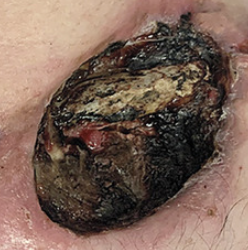Clinical images are presented of bilateral enlarging chest wounds in a patient with a 3-year history of daily use of fentanyl adulterated with xylazine. The necrotic wounds in the upper chest were infected by Pseudomonas aeruginosa and an enterococcus species. A computed tomography scan showed osteomyelitis of the clavicles, which were exposed.
“A diagnosis of xylazine-associated skin injury complicated by soft-tissue infection and osteomyelitis was made,” the authors write. “Chest-wall débridement and microsurgical flap reconstruction were performed. Intravenous antimicrobial therapy was initiated on admission and continued for 6 weeks postoperatively. Buprenorphine therapy was initiated to treat the patient’s opioid-use disorder. Xylazine (also known as ‘tranq’) is an α2-adrenergic receptor agonist that has been approved only for veterinary use. It is an increasingly prevalent additive to fentanyl in the United States. Xylazine is associated with skin injury — commonly on the legs — that can occur regardless of the site of injection. At the 6-month follow-up visit, the patient’s wounds had healed well, and he had been participating in an outpatient addiction program.”

